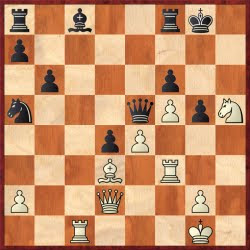Sofia BUL, WCC 2010 game_4 Sofia BUL (4), 28.04.2010
1.d4 Nf6 2.c4 e6 3.Nf3 d5 4.g3 dxc4 5.Bg2 Bb4+ 6.Bd2 a5 7.Qc2 Bxd2+ 8.Qxd2 c6 9.a4 Yet another know-how by Kramnik. However, after: 9...b5

Anand deviated with a novelty: 10.Na3N Instead in the first game from the match Kramnik-Topalov, Elista 2006 White played: [10.axb5 cxb5 11.Qg5 which is nowadays the main theory. Curiously, the last game in my Megabase is Meier-Wojtaszek from the ETCC in Novi Sad this November. As far as I know Anand allows to his seconds to play the lines that they have studied after the match is over. I wonder when exactly did the world champion start his preparation for the Catalan- for this one, or for the previous?! The move itself is very reasonable, White developes a piece, and puts strong pressure on the opponent's pawns and center. The compensation that appears is quite typical for some lines of QGA and Slav Defense.] 10...Bd7 Black had a choice of giving back his extra pawn in order to speed up his development- [10...Bb7 11.axb5 cxb5 12.Nxb5 0–0 13.0–0 Bd5 14.e3 White is better structurally, but Black's active pieces might compensate this- for example Qd8-b6 and after this even to b7, Nb8-c6, and Rf8-b8. Still, this is quite risky from strategical point of view, as if White manages to win a pawn on the queen's flank, the resulting endgames 5 versus 4 pawns are most often lost. ] 11.Ne5 Nd5 12.e4 Anand temporarily closes his Catalan bishop, but the central break-through d4-d5 will follow soon. 12...Nb4 13.0–0 0–0 14.Rfd1 Be8 15.d5! Typical and strong. Until here Anand had spent only twenty minutes on his clock, a good sign for thorough opening preparation. 15...Qd6! The best defense. [15...Qb6 leaves the queen too far away from the king's flank. White can continue with: 16.dxe6 (16.Ng4!?) 16...fxe6

17.Qd6!! Qxf2+ (17...Nd3 exchanging the mighty knight might be best for Black, although his position is hard to envy after: 18.Nxd3 cxd3 19.axb5 Qxf2+ 20.Kh1 Qxb2 21.Rf1 Bf7 22.e5±; 17...Rxf2 18.Kh1! Rf8 19.Rf1! gives decisive attack for White) 18.Kh1 Qxb2 19.axb5 cxb5 20.Rdb1 Qe2 21.Qxe6+ (21.Rf1!?) 21...Kh8 (21...Bf7 22.Nxf7 Rxf7 23.Rf1+-) 22.Nxb5 and White is clearly on top.(22.Rf1!?) ] 16.Ng4 The Indian keeps the pressure and preserves the pieces on the board. The straightforward: [16.Nxc6 N8xc6 17.dxc6 Qxd2 18.Rxd2 bxa4 19.Nxc4 Bxc6 leads to massive exchanges and almost certain draw.] 16...Qc5 17.Ne3 N8a6 18.dxc6 bxa4 19.Naxc4 Bxc6 20.Rac1 White has a slight edge.

Up to here both the players played their strong and logical moves. Who could possibly immagine that Topalov will riun his position after only three normal moves?! 20...h6 After seeing the course of the game we can advise Veselin to keep his queen close to the king's flank, but there is a danger for it to be cut-off from the game there: [20...Qh5 21.Nd6 Rad8 22.Qd4 Bb5 23.e5; 20...Qe7 is another good after-game advice...] 21.Nd6 Qa7 22.Ng4 This was a move that Zurab Azmaiparashvili was recommending, having in mind the following sacrifice. 22...Rad8

It is even hard to call this move a mistake, although Black is now losing by force: 23.Nxh6+!! A move that even the engines cannot find easily (if at all). 23...gxh6 24.Qxh6 f6 There is no salvation in the other lines neither: [24...e5 25.Qg5+ Kh7 (25...Kh8 26.Qf6+ Kg8 27.Nf5 is mate in four.) 26.Bh3! threatening mate, and Black is forced to part with lots of material: 26...f5 27.Bxf5+ Rxf5 28.Qxf5+ Kg8 29.Qg5++-] 25.e5! [25.Bh3 is another reasonable move, but it leads only to a draw after: 25...Qe7 26.Rxc6 Nxc6 27.Bxe6+ Qxe6 28.Qg6+ Kh8 29.Qh6+] 25...Bxg2 26.exf6!

26...Rxd6 [26...Bf3 27.Qg6+ Kh8 28.f7 or(28.Rc4- Rogers both lead to forced mate) ] 27.Rxd6 Be4 28.Rxe6 Nd3 29.Rc2 Qh7 30.f7+ Qxf7 31.Rxe4 Qf5 32.Re7 In the interview for the Bulgarian National Television D-r Stefan Sergiev, the president of BCF praised highly the game, and gave his respect to the brilliant play of the world champion. There were also many positive reactions from Bulgarian players and fans, as Anand abandoned the passive positional approach and came back to his true active positional style. However, Krasi Kushev, candidate master and leading journalist from BNT reminded us that Topalov is usually playing better in the second part of the events, and we can wait for his come-back after the rest day tomorrow. 1–0














